
3 minute read
Everything you wanted to know about CONSTRUCTION LOAN FINANCING
By Corey Verhel
Planning a major renovation or remodeling project? Unless you are paying cash for your project, you will need a construction loan to pay for the materials and labor, and you can use it to buy the land as well. Construction loans are a bit more complicated than conventional mortgage loans because you are borrowing money short-term for a building that does not yet exist. A construction loan is essentially a lineof-credit, but with the bank controlling when money is borrowed and released to the contractor. Additions or remodel projects are categorized similarly to new construction financing with most lenders as well.
Both you and your contractor must be approved for the loan. The bank wants to know that you can afford the loan with enough cash left over to complete the house, and that the contractor has the financial strength and skills to get the house built on time and on budget. Some lenders will allow you to be involved in the project as a contractor, some lenders specifically prohibit that. You will need to convince the bank that you have the necessary knowledge and skills to get the job done on time and on budget.
If you are converting the construction loan to a mortgage when the building is completed, the bank also wants to know that the finished building plus land will have a high enough appraised value to support the mortgage. Because the lender needs to know the story behind the project, and believe that you can make it happen, construction loans are sometimes referred to as “story loans.” There are many variations on these types of loans from lender to lender, and they change frequently, so you should talk to a few different lenders to see what plan is best for you.
Construction loans are definitely harder to find than conventional mortgages, not every lender offers this type of financing. Luckily there are some strong lenders in the Northland that do offer construction financing. Simply starting with your local bank where you already have a relationship is good, but you will also want to speak with other local banks, including community banks and credit unions, that are more likely to make these types of loans.
In all construction loans, money is disbursed by the lender based on a preestablished draw schedule. Funds are released in stages, upon completion of the foundation, upon completion of the rough frame, and so on. The title company of your choice handles all of the draws. Monthly interest only payments are made on the balance from the draws, until everything is completed properly and the owner is issued a certificate of occupancy (CO).
Traditional construction loans
A traditional, or two-time-close, loan is the most common type of financing, it effectively is two separate loans — a short-term loan for the construction phase and then a separate permanent mortgage loan on the completed project. Essentially, you are refinancing when the building is complete and need to get approved and pay some closing costs in order to set up the new “end” loan.
Because of two loan processes, some costs will be greater for this type of loan. However, you typically will get a better rate on the permanent mortgage as you will be working with mortgage refinance rates, which are typically more competitive than the rates offered in onetime-close loans (see below). While it is easiest to stick with the same lender for the permanent financing, in most cases you will be free to shop around to make sure you are getting the best rate and terms.
One-time close construction loans
Also called “all-in-one loans” or “construction-to-permanent loans,” these wrap the construction loan and the mortgage on the completed project into a single loan. These loans are best when you have a clear handle on the design, costs and schedule, as the terms are not easy to modify. The loan has one approval process and one closing, simplifying the process and reducing the overall closing costs. However, due to the difficulty of managing the project timeline, especially in our local building area, these loans are harder to find as many lenders and/or title companies do not offer them.
Steps to qualification
If you are in the market for construction financing, it is advisable to get pre-approved for the financing well ahead of the actual building process. Getting pre-approved will allow you to set your budget. Once pre-approved, the fun, and sometime stresses, of the project can begin. Building plans with specifications, a materials list (known as a Sworn Construction Statement) with cost estimates and bids, and putting all of the finite details together with your builder are the next steps to building your dream home or construction project. D
Corey Verhel is a mortgage banker with Frandsen Bank and Trust of Duluth. He can be reached at 218-673-5024 or cverhel@frandsenbank.com. We fabricate and install all solid surface and stone countertops!













